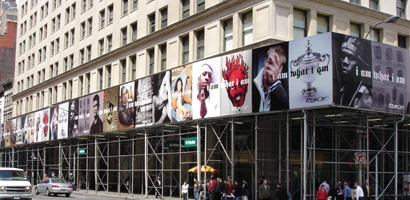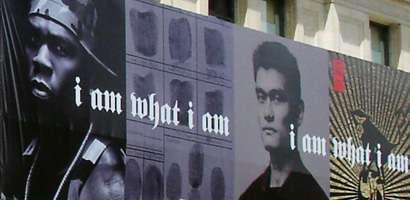This past February a giant scaffolding went up (and) around the International Toy Center, a building that occupies the full corner of Broadway, 23rd and 24th Streets — a big edifice, in a big location, no doubt. One heavily snowy morning soon after, walking down on 23rd on my way to work, the scaffolding had been covered up — overnight it seemed — and first Jay Z, then Allen Iverson and 50 Cent, followed by Lucy Liu and finally Yao Ming were staring down at me, daring me not to slip (myself or my coffee) as I peered upwards back at them. The combination of celebrities was interesting enough to grab my attention, despite the piercingly cold snowflakes in my eyes, but it was the type style that finally tripped me: Blackletter.

Blackletter is the only style — that I can think of — that is a crossover. In its similarly diverse variations — texturas, frakturs, rotundas, and schwabachers — it is equally appropriate on beer labels and fashion labels; similarly kitsch on the facades of quaint bed & breakfasts and covers of heavy metal albums; thoroughly serious on newspaper mastheads and diplomas or certificates; and as recognizable as the identifier for Pushpin’s Monthly Graphic and the regime of Nazi Germany.
There is a default association between blackletter and the Nazis, further enhanced by period pieces (posters, video games, books) created today that employ blackletter when referring to WWII, Nazis, Germany or a combination thereof; as well as the adoption of blackletter by Neo-Nazis. In 1941 through a memo from Martin Bormann — Hitler’s “most faithful party comrade” — the Nazi Government officially denied blackletter, or Fraktur, as theirs, taking the opportunity, even, to pass the type style’s origins and blames to the Jews. Additionally, in that same memo, they proclaimed Antiqua, a serif, as their official typeface. Regardless of their efforts to distance themselves from the oppressive and emotionally aggressive use of blackletter it is a tough task to disassociate blackletter from the atrocities of World War II.
And it’s easy to forget that Gutenberg’s Bible was set in blackletter. But this is not about Nazis or Bibles.
Today, younger generations hardly associate this style to that period or that book. To GenYers blackletter stands for dangerous, edgy, hip and daring. It is an optimal and fine choice for a tattoo — “mom” set in blackletter is cool. Rock stars, actors (the baaad ones), professional athletes and rappers have chosen blackletter as their type of permanent self-expression. So it comes as no surprise that Reebok, looking to bridge the gap between hip hop, sports and youth culture would use blackletter in their recent worldwide, multimillion dollar “I am what I am” campaign.

This campaign focuses, as stated on a press release, on individuals “who stand out from the crowd because they are true to themselves, challenge the status quo and do things in their own unique way,” and who ultimately represent what Reebok wants to stand for: Individuality and authenticity. The complete roster of celebrity endorsers are hip hoppers Jay-Z and 50 Cent; super athletes Allen Iverson, Andy Roddick, Kelly Holmes, and Yao Ming; skateboarder Stevie Williams and soccer star Iker Casillas who are sure to provide strong authenticity due to their niche sports. And finally, the oddest choice to fill the actor slot, Lucy Liu, as if at the last moment Reebok decided it needed to appeal to a female audience or, alternately, cashing in on Liu’s beheading Kill Bill appeal. (Trust me, if it were intended for a purely male audience, more suitable — read, and pardon the objectifying, hotter — actresses would have fit the bill).
The choices — at least the ones with the more popularity: Jay Z, 50 Cent and Iverson — have a stronger allure, and a more important message to impart, than “challenging the status quo”. These are boys who grew up in impoverished neighborhoods with every card in their deck sharply against them. Jay Z’s ad reads: I got my MBA from Marcy Projects. His TV spot then shows him in a fitting with a bespoke tailor. The message is clear: If he can do it, so can you — so why not do it in a pair of Reeboks?
The campaign — created by mcgarrybowen — has many things in its favor. Large budget. Smart — okay, more like obvious — ad placement (large urban areas, subways and TV spots that aired initially during the NBA All-Star Game). A famous-by-relationship director in Jake Scott, son of Ridley Scott. International appeal, which explains the soccer and tennis stars. And lastly, the best typeface for the job. Linotype’s Fette Fraktur. I am sure many typefaces would have done a good-enough job but not a single one would have been able to embody so many things all at once. With blackletter Reebok is speaking to the various groups in its audience. It talks to the kids playing one-on-one on a wet, cement court. It talks to the guy who keeps a beat in his head constantly. It talks to anyone who dreams of making it. It even talks to the young girl who can stand on her own. Few of the communication elements we work with, as graphic designers, can do that. Blackletter can, at least for now.






Armin, what a great post!
A lot of type designers and graphic designers (including myself) sit and around and spend (way too much time) bemoaning the disappearance of Blackletter styles from the visual landscape (especially as a book face… the holy grail of fine type setting).
This a great example of how Blackletter can be used in a contemporary manner.
There is so much about Blackletter type that could be said additionaly here. Instead, I'll link to a few great threads on Typophile and Typographica.
Nazi Taint; Overused Typefaces?
Where is the Blackletter?
Blackletter Special Interest Threads
Bello Logo Discussion on Typographica
I agree that Fette Fraktrur is a good face for this job, but it is important to remember that there are many other great Blackletter faces, and many other styles of Blackletter aside from Fraktur. Fette Fraktur gets so much relative use that it is practically the "Helvetica" of Blackletter faces!
On Apr.09.2005 at 04:00 PM